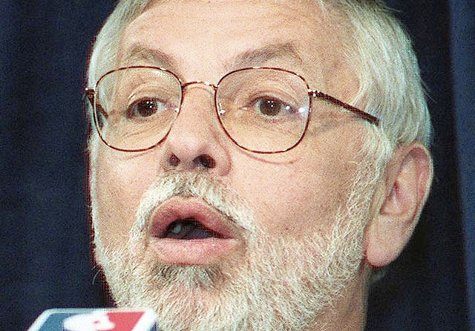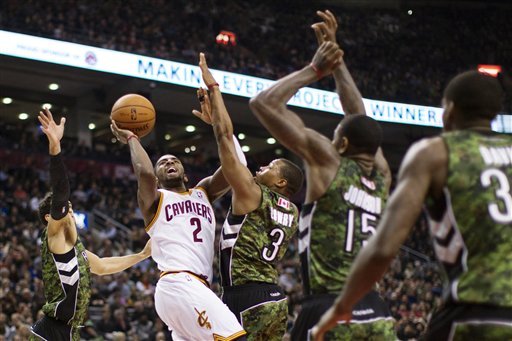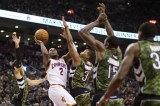
Ryen Russillo from ESPN had Russ Granik, Larry Coon and Chris Sheridan on to discuss where the NBA’s labor (labour?) agreement stands and what the major issues were. It’s well over an hour long and here are some of the take-home points.
The major number that is up for negotiation is the percentage of BRI (basketball-related income) that should go to the players, currently that is 57%. The NBA’s long-term goal is to see a 50-50 revenue-sharing scheme, which would be a significant blow to the players. In addition, the BRI is currently calculated on the NBA’s gross revenues, and the owners want to change that to be a percentage of net revenues, a massive difference that could conceivably slash salaries by a third. In addition to that, the owners currently take $600 million right off the top of the $4.2 billion in revenues, they want to increase that number to $1.5 billion, and then apply the BRI percentage to the remainder. The players are being asked to concede a lot.
The total from which the BRI should be calculated is going to be a major issue of contention. From the players perspective, they met the owners’ demands of “cost certainty” in the 1998 negotiations, which allowed the owners to control the maximum they could spend on salaries. Twelve years later, the league is still bleeding. The owners have now changed their stance on revenue-sharing and want “profitability certainty” – a guarantee that they will make profits.
The players point out that they’re conceding and compromising everytime a CBA is being bargained, and that the owners are exaggerating their woes through legal but dubious accounting practices, amongst others. For example, some teams are ammortizing expenses related to buying a team and expensing it out as a loss when they are clearly capital costs. Although there’s nothing illegal about this, the idea that the cost of actually owning the team (not operating it) is being passed on to the players is meeting with understandable resistance.
The possibility of losing an entire season was articulated in eerie terms by Larry Coon. “The down side of losing a whole season is less than the downside of playing another season in a system [the owners] see as broken”, said Coon. Former NBA Deputy Commissioner, Russ Granik, echoed the same sentiments which ESPN analyst, Chris Sheridan, was only too agreeable with. Who is at fault for the current state of affairs appears to be a moot point, and the owners’ focus is on rectifying what they claim is an unsustainable model. The NBA’s revenues have been steadily rising to the current $4.2 billion and the owners have a hard time accepting that despite a steady revenue stream, the league is in the red.
According to Sheridan, 22 teams are losing money with the total losses accumulating to $450 million. The eight teams (Raptors amongst them) that are profitable are bringing in $150 million, for a net loss of $300 million. If these numbers are true, the disparity between small and big market teams will continue to grow, which is one of the reasons why the NBA is pursuing a hard cap. A hard cap would imply the elimination of Bird rights – the loophole that allows teams to sign its own free-agents despite being over the cap – but that is seen as contrary to the charter of closing the disparity, and thus most experts believe a soft cap will remain.
Sign-and-trade clauses are seen as a major problem as they provide a loophole for teams who cannot afford a free-agent (because of being over the cap) to shed short-term contracts for long-term escalating ones, thus ultimately proving costly and shattering team-expense barriers. Details such as mid-level exceptions, maximum salaries, rookie-scale contracts are not viewed as major issues because they are all encompassed by the all-important BRI percentage number (currently at 57%) which the owners are desperately looking to lower. The thought is that the number would have to be lowered at least to 55%, with the NBA probably settling at 52%.
All three experts agree that this will be a long and drawn out process that will take a considerable amount of time to sort out. The key date is November 15th which is when 90% of the players will miss their first pay cheques and reality hits home. Until then it is a theoretical discussion which the owners are willing to waddle through before letting the effect of the ides of November take place. Big salary players can afford to go through an entire season without pay. However, players making minimum salary while hanging on to the fringes of the NBA will suffer a major financial hit, which could end up costing them the majority of what they’d make in their career. Veteran players in the later stages of their career will also be penalized as time is running out on their playing days. The prevalent notion is that the longer this drags on, the more it is to the owners’ advantage. If they’ll get a good deal now and a great deal later, they’ll wait for the great deal.
—
Obligatory comment on Sonny Weems being extended a qualifying offer:
This guy has a lot of detractors and understandably so. Maybe it’s his countenance, but it just looks like he’s exerting the absolute bare minimum effort out there which has a lot of fans wondering whether he fits into the current “culture shift” taking place. His effective mid-range game was on the decline last season and since he doesn’t bring much of anything else, his value to the team was so low that James Johnson usurped him rather easily by making a couple cross-court passes. Those are the negatives.
The positives are that he’s a cheap option who can be a role player on a rebuilding team. He doesn’t require long-term financial commitment, has the talent to be a serviceable player. I can’t imagine any team out there offering him a significant deal, and the Raptors could just end up re-signing him to a one year deal at the qualifying number of $1.09 million. With Weems the Raptors now have 11 players under contract for next season. Hey man, you need bodies and Weems is a cheap one, look at it that way. He’s also part of that ridiculous YGZ program and maybe it’s partially to appease DeRozan.
Julian Wright ($3.95M), Joe Dorsey $(1.09M) have qualifying offers which were not extended. Wright’s number is simply too high so I doubt the Raptors would look at him, especially with James Johnson and Linas Kleiza in the fold. Dorsey’s number is reasonable but if Bargnani is being tested at the four, then there becomes a real logjam at the position, and I don’t see the Raptors being interested in Dorsey.



